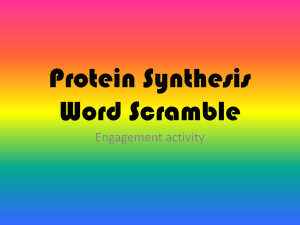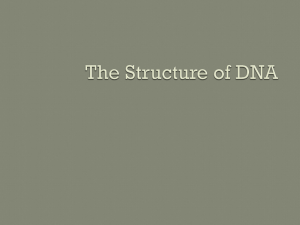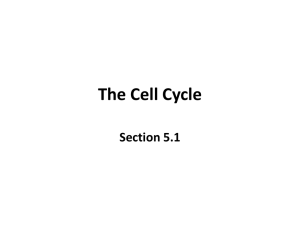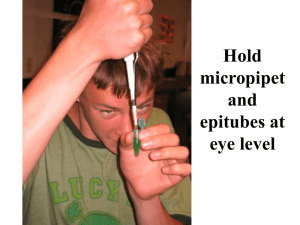DNA Replication PowerPoint
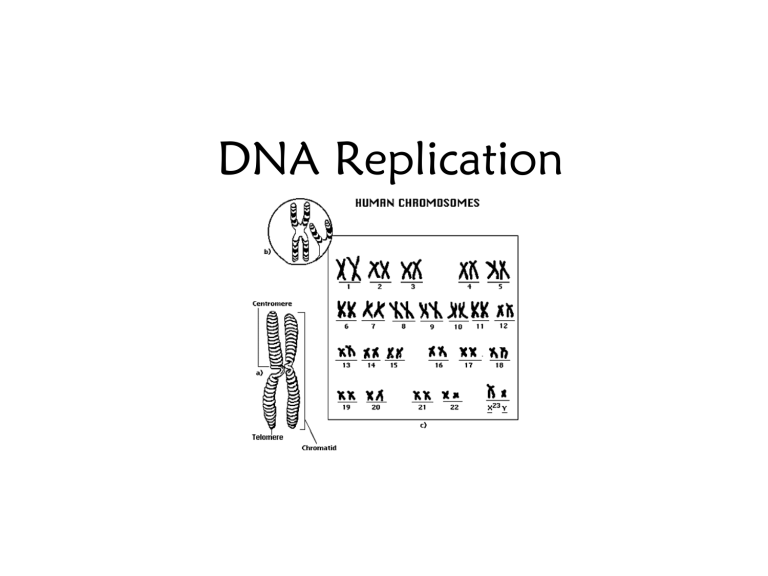
DNA Replication
What is it?
• DNA Replication
– Process of copying the DNA in a cell before it divides
• How much DNA do we need to copy?
– bacteria: 3 million base pairs
– humans: 3 billion base pairs
Where does it happen?
Why does it happen?
?
• So daughter cells have a complete copy of the parent DNA
?
?
?
When does it happen?
• Remember synthesis phase in mitosis?
• Interphase
– S phase = Synthesis
How does DNA replicate?
“ semi-conservative ” : half of each new strand is the old strand
How does DNA replicate?
1. Replication Fork
– Site where DNA is separated and copied
The Enzymes
2. Helicase : separates or “ unzips ” the 2 strands of the double helix
– Breaks Hydrogen Bonds
The Enzymes
3. DNA polymerase : inserts appropriate bases
– Proofreads the bases to make sure that they are paired correctly
How does DNA replicate?
4. Replication Fork
– Nucleotides are added in 5 ’ 3 ’ direction
• Anti-parallel
• Okazaki Fragments
Video Clip
• http://highered.mcgrawhill.com/olcweb/cgi/pluginpop.cgi?it=swf::
535::535::/sites/dl/free/0072437316/1200
76/micro04.swf::DNA%20Replication%20
Fork
Write the complementary DNA strand for each of these DNA strands:
DNA
• GAATTACA
• CCAATTAG
• ATAGACAG
• CCAGTACA
DNA
• CTTAATGT
• GGTTAATC
• TATCTGTC
• GGTCATGT
What ’ s in a chromosome?
• DNA + histone proteins
What ’ s in a chromosome?
• DNA + Histone = chromatin
• Chromatin beads nucleosome
• Nucleosome packed and coiled
Chromosome
DNA Replication Review
1) Each strand of the double helix of DNA serves as a __________ or model, for the new strand
2) Sites where DNA separation & replication occur are called: __________ __________
3) DNA separates into two strands by the enzyme called __________.
DNA Replication Review
4) The enzyme ________________ adds bases along the original DNA strand.
Two new strands form, following the rules of
__________
5) Nucleotides are added in direction
DNA Replication Review
6) DNA + Histone = _______________
7) Chromatin beads _______________
8) Nucleosome packed and coiled
_______________
INTRODUCTION
Grade 10 Biology MCAS
OPEN RESPONSE QUESTION
The following is an Open Response question. It is important to practice answering these types of questions in preparation for the state mandated MCAS. This exercise will walk you through the process. There will also be some reference links to assist you.
Be sure to...
Read all parts of each question carefully.
Make each response as clear, complete and accurate as you can.
Proofread your work!
In 1950, Erwin Chargaff and colleagues examined the chemical composition of DNA and demonstrated that the amount of adenine always equals that of thymine, and the amount of guanine always equals that of cytosine. This observation became known as Chargaff's rule.
a.
Based on current knowledge of the structure of DNA, explain the basis of Chargaff's rule.
b.
The diagram below represents a single-stranded segment of DNA. In your Student Answer Booklet, write the complementary DNA strand that would form from this strand during replication. Use the letters A, C, G, and T to designate the bases: A = adenine; C = cytosine; G = guanine; T
= thymine.
c.
Why is Chargaff's rule so important to DNA's ability to replicate itself accurately?
Now that you ’ ve finished the problem,
Scoring Intro
MCAS Open Response questions are graded as either a
4,3,2,1 or 0 with 4 being the best possible score.
The following pages are examples of work done by other students who earned those scores.
Please use the example of a 4 to check your answers.
You will also see the guidelines that were used to grade these answers. As you look over these pages, try to rate your own answer as a 4,3,2,1or 0.
This student earned a
What is a 4?
The response demonstrates a thorough understanding of
Chargaff ’ s Rule and the composition of
DNA .
This student earned a
What is a 3?
The response demonstrates a general understanding of
Chargaff ’ s Rule and the composition of
DNA .
This student earned a
What is a 2?
The response demonstrates a limited understanding of Chargaff ’ s
Rule and the composition of
DNA .
Sample Score 2
This student earned a
What is a 1?
The response demonstrates a minimal understanding of understanding of
Chargaff ’ s Rule and the composition of DNA .
Sample Score 1
This student earned a
What is a 0?
The response is incorrect or contains some correct work that is irrelevant to the skill or concept being measured.
Sample Score 0
EVALUATION
Now that you ’ ve seen how the scores are graded, how did you do?
Try to rate yourself.
Would you say that you earned a 4,3,2,1, or 0?
CONCLUSION
Hopefully, this has been a helpful experience for you.
The only way to improve is to practice, and there are other problems like this one available for you to try if you are up to the challenge!
-- or --
Call a friend, have them do the same problem and you can talk about it.
-- or --
Take a break, you ’ ve earned it!
BINGO
• Deoxyribonucleic Acid
• Adenine
• Guanine
• Cytosine
• Thymine
• Base pairs
• Sugar
• Phosphate group
• Deoxyribose
• Double Helix
• Chromosomes
• Chromatin
• Histones
• Prokaryote
• Parent Strand
• Replication Fork
• DNA helicase
• DNA polymerase
• 5 ’ to 3 ’
• 3 ’ to 5 ’
• Okazaki Fragments
• Leading strand
• Lagging strand
• Anti-parallel
• Semi conservative
• Nucleosome
• Beads
• S phase
• Interphase
• Spiral Staircase
• Sides of Ladder
• Rungs of Ladder
• Nitrogenous Base
• Purine
• Pyrimidine
• Nucleotide
• Complementary
• Nucleus
• Cytoplasm
• Hydrogen Bonds
• Covalent Bonds
• Chargaff's Rule
• Eukaryote
• Daughter strand



